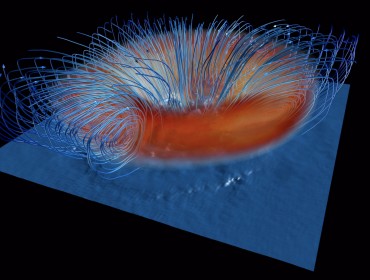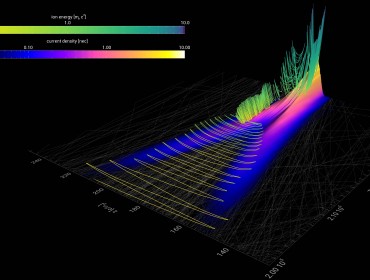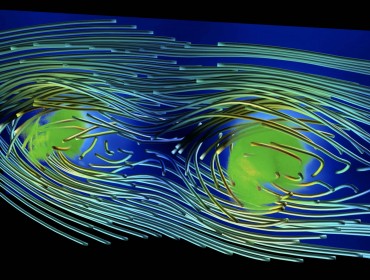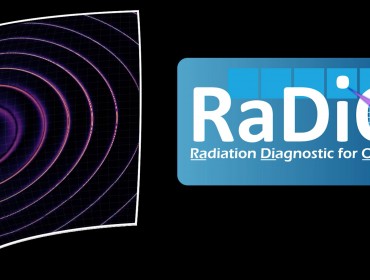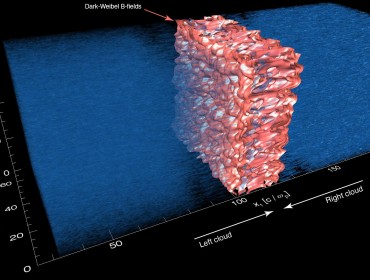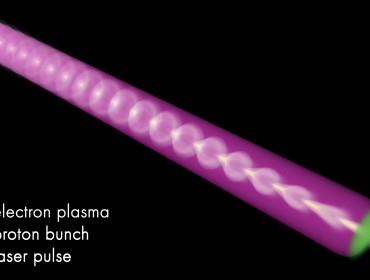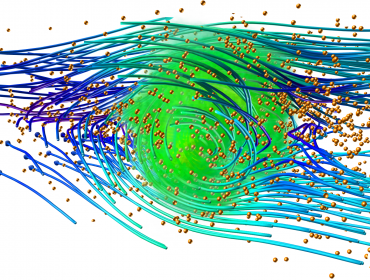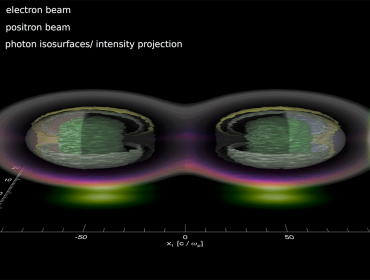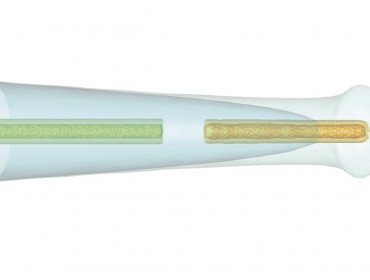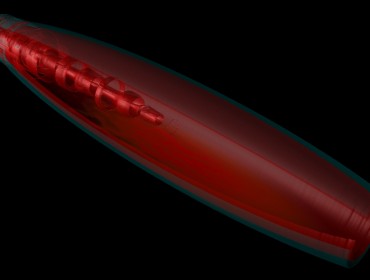-
Fountain currents and Biermann fields at target surface
Read moreFinding the origin of magnetic fields starting from unmagnetized plasmas constitutes a long-standing quest in plasma physics . This fundamental and intriguing problem has implications not only in astrophysics but also in laboratory plasmas. In fact, one of the main unanswered questions regards the genesis of the magnetic fields found throughout the universe. On the other hand, in a laboratory, long-lived magnetic fields can be created via the interaction of intense lasers with plasmas, in what is considered one of the most exciting emerging new branches of plasma physics. Laboratory experiments will indeed allow reproducing astrophysical mechanisms under controlled conditions favoring a physical insight that would be otherwise inaccessible.
The Biermann battery has often been invoked as a possible mechanism for magnetic field generation in unmagnetized plasmas . The Biermann battery acts in an unmagnetized plasma when its temperature and pressure gradients are perpendicular to each other. In such plasmas,…
January 22, 2019 -
Speiser and Dahu orbits: the trappings that heat you up!
Read moreFigure 1: Speiser and Dahu orbits: the trappings that heat you up!
High-energy particles are ubiquitous in the universe, from jets at the center of the galaxies to the Solar Wind. Understanding the different mechanisms responsible for this acceleration is one of the most challenging questions of contemporary plasma studies. The standard approach to address this question is using kinetic models, both numerical and theoretical, in order to deeply understand the dynamics of the particles involved.
Figure 1 shows the result of a numerical simulation of a collisionless plasma performed with the particle-in-cell code OSIRIS 4.0 in which is represented one mechanism for thermal acceleration (heating). As the title says, this mechanism is connected with the trapping of particles between two approaching current sheet profiles.
Figure 2: (Top) Radial current jx (black) and toroidal magnetic field By (blue) profile. The dashed gray lines delineate the regions of the different particle trajectories: the…
January 18, 2019 -
QED strength magnetic reconnection triggered by radiative compression
Read moreIn astronomical phenomena such as neutron stars, the strength of the magnetic field can be extremely large, approaching the quantum Schwinger field (4.4 x 1013 Gauss). At these strengths, pair production can occur leading to a plasma dominated by electron-positron pairs. It is inevitable that magnetic reconnection occurs at some points in the magnetosphere. In the context of this reconnection, multiple flux-tubes referred to as magnetic islands can be found. Compression of the fields of a magnetic island leads to enhanced radiative cooling, and in turn further compression. The resulting runaway process leads to quantum electrodynamic (QED) effects such as pair production.
We have performed a 3D ab initio PIC simulation of magnetic reconnection, starting from a Harris equilibrium pair plasma, where most of the energy is in the form of magnetic fields, which takes into account hard photon emission and pair production at the rates predicted from QED. The…
January 17, 2019 -
Radiation from charged particles in a helical trajectory
Read moreThe scales associated with this radiation are typically orders of magnitude smaller than the scales associated with the particle’s motion, thus, resolving such small scales would increase the number of operations beyond what is currently computationally possible. Consequently, the spatiotemporal behaviour of the radiation emitted by charged particles either in a plasma or a synchrotron environment remains fairly unexplored and to the best of our knowledge, no theoretical predictions have been made on the spatiotemporal signature of any kind of motion. However, the spectral properties of radiation are well documented for some common types of motion as typical synchrotron light sources generate radiation by making relativistic, ultra-fast particles undergo a sinusoidal or helical motion inside periodic magnetic structures known as wigglers or undulators. Such conditions can also be obtained in a plasma using relativistic plasma waves instead of magnetic structures or EM fields. The Radiation Diagnostic for OSIRIS (RaDiO)…
January 17, 2019 -
Electromagnetic-like dark matter self-interaction
Read moreWeak dark matter (DM) self-interactions are a natural and well-motivated possibility, with possible observable consequences for large scale structure and halo dynamics. A minimal type of DM self-interaction is “dark electromagnetism”, which could cause DM to exhibit collisionless plasma-like collective behavior . This possibility raises the question of whether plasma instabilities may have a significant impact on the galaxy and cluster dynamics. Resolving this will determine whether or not such an interaction is consistent with current observations, and whether plasma instabilities may have a significant impact on galactic dynamics.
Two-dimensional PIC simulations were performed using two identical, collisionless e− e+ DM plasma clouds (shown in blue color). This picture depicts the interaction of two dark e− e+ plasma clouds mimicking the merger of two DM halos, such as in the Bullet Cluster. A transverse Weibel magnetic field (shown in red color) grows during the interactions which deflect the…
January 17, 2019 -
Flying cavity: micro-bunching of protons for electron acceleration
Read moreWhile conventional particle accelerators have been used in the past to answer fundamental physical questions, their technical limits have been reached. An intrinsically different approach is provided by plasma-based accelerators. Utilizing the properties of a plasma, acceleration gradients which are orders of magnitude higher compared to conventional accelerators can be achieved. Recent experiments have shown utilization of a long proton bunch provided by CERN’s Super Proton Synchrotron (SPS). In the experiment, a long proton bunch is co-propagated through a 10 m long gas vapor together with a laser pulse which ionizes the gas and creates an electron plasma column. With the help of the self‑modulation instability (SMI) the long proton bunch is sliced in micro‑bunches driving plasma wakes. Thus wakes allow the acceleration of electrons up to several gigaelectronvolts over a short distance.
Our work presented in the video depicts a simulation for the generation of micro‑bunches by the…
January 17, 2019 -
Magnetic reconnection of QED strength fields with hard photon radiation emission
Read moreIn astronomical phenomena such as neutron stars, the strength of the magnetic field can be extremely large, approaching the quantum Schwinger field (4.4 x 1013 Gauss). At these strengths, pair production can occur leading to a plasma dominated by electron-positron pairs. It is inevitable that magnetic reconnection occurs at some points in the magnetosphere. In the context of this reconnection, multiple flux-tubes referred to as magnetic islands can be found. Compression of the fields of a magnetic island leads to enhanced radiative cooling, and in turn further compression. The resulting runaway process leads to QED effects such as pair production.
We have performed a 3D ab initio PIC simulation of magnetic reconnection, starting from a Harris equilibrium pair plasma, where most of the energy is in the form of magnetic fields, which takes into account hard photon emission and pair production at the rates predicted from QED. The image…
January 16, 2019 -
A step towards the shiny horizon beyond matter
Read more
Intense and energetic gamma ray sources with tabletop earmark may be available soon. Such photon beams can be generated through beamstrahlung radiation emitted when two dense and relativistic charged beams collide.
Density and energy of the colliding beams is crucial to approach the quantum regime, where the efficiency of the emission process allows to convert a relevant fraction of the kinetic energy of the primary beams into electromagnetic radiation. The quantum regime occurs when the electromagnetic field strength approaches the Schwinger limit.
Such extreme condition can be reached when dense and relativistic charged beams collide as the strong collective field of one beam is boosted in the relativistic frame of the counter propagating beam thus approaches the Schwinger limit in one particle bunch rest frame. Beamstrahlung radiation is connected with other two phenomena: disruption effect and pair creation.
Disruption rises when the particles of one beam are strongly bent by…
December 7, 2018 -
Acceleration achieved in a hollow plasma channel
Read moreRecent experiments have unravel the potential to efficiently accelerate electrons of plasma wakefield accelerators .
In this context we have been investigating the formation of a plasma scheme suitable for accelerating positrons to high energies. The setup consists of a tightly focused energetic positron bunch that travels through an uniform plasma of electrons and ions. It’s space charge is capable of not only bringing electrons towards its axis of propagation as it repels ions strongly enough, and for long enough, to have them form…
May 24, 2018 -
Exploring the onset of oblique instability in realistic finite beam-plasma system
Read moreRelativistic high-density neutral electron-positron (fireball) beams have been recently generated in the laboratory providing a platform to explore processes directly to address unsolved problems in astrophysics. Ab initio PIC simulations of astrophysical plasmas have provided new directions to identify the role of plasma instabilities in the formation of collisionless shock, the particle acceleration processes, and the generation of magnetic field structures compatible with the intense radiation bursts of synchrotron radiation. Recently, it has been proposed that the available 20 GeV electron and positron bunches at the Stanford Linear Accelerator Center could be used to investigate a purely transverse filamentation instability using a short fireball (e-, e+) bunch (i.e. shorter than the plasma wavelength) .
In this work, we performed 2D cylindrical PIC simulation considering the interaction of a long fireball beam (longer than the plasma wavelength) with static neutral plasmas. The development of oblique instability has been observed due…
January 18, 2018
extreme plasma physics > Visualizations

